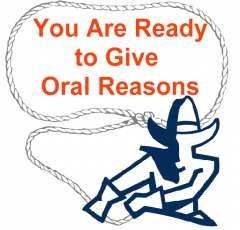Preparing and Giving Oral Reasons
Preparing and Giving Oral Reasons

What are Oral Reasons?
- Brief oral presentation given to an official judge explaining how you placed a class.
- Less than 2 minutes in length.
- Worth a maximum possible score of 50 points.
Why give Oral Reasons?
- Close placings in a judging class are subjective and debatable.
- Gives you an opportunity to "sell or defend" your opinion.
- Will make you a better thinker, a keener analyzer, a better speaker, and a more confident person.
The Three (3) Parts of the Reasons Process
- Organization and Note Taking.
√ This is done while judging the class. - Terminology.
√ This is practiced on your own at home and throughout your judging career. - Delivery & Presentation.
√ This deals with the actual presentation in the contest reasons room.
Accuracy is Everything!!
Accurate Notes
+ Accurate Terminology
+ Accurate Delivery
= High Reason Scores
What's Your Goal
- The goals for your oral reasons should be:
√ Accurate content.
√ Fluent or smooth delivery.
√ Outstanding terminology.
♦ Beginners → do not be discouraged if your reasons are choppy in delivery or simple in terminology, as long as accuracy is maintained.
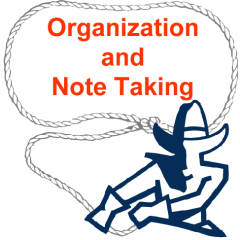
Organization and Note Taking
- Accurate note taking while judging the class is the first and most important step in giving a good set of oral reasons.
√ Helps organize your thoughts.
√ Enables you to develop a mental image of the animals after judging the class.
Three (3) Types of Notes
There are three (3) types of notes that should be taken for a reasons class:
- Identification (ID) notes.
- Individual notes.
- Comparative or pair notes.
Idenfitication (ID) Notes
- These are notes that identify any unique traits (such as color, sex, crimped ear, bob-tailed, frostbit ears, etc.).
- ID notes help you visualize the animal.
EXAMPLES: "the red barrow"
"the heifer with frostbit ears"
- ID notes also give you an additional way to refer to the animal.
EXAMPLE: "I placed the red barrow third."
Individual Notes
- These notes indicate traits that a particular individual is either best or worst in as compared to the class.
EXAMPLES: "the heaviest muscled lamb"
"the poorest structured bull"
- These should only be used when an individual animal is obviously the best or worst for a trait.
- Usually most effective for the top or bottom placing animals.
Comparative or Pair Notes
- These notes are used to compare traits between the animals of each pair.
EXAMPLE: "I placed 1 over 2 because he was the nicer balanced, cleaner fronted lamb of the pair."
- Notice that the words used in comparative notes usually end in "er". (In this case nicer and cleaner).
Coupling Strategy
- A coupling strategy is used to introduce a pair of animals that are similar in either ID or individual traits.
EXAMPLES: "finding the top pair to be the highest volume heifers in the class, I placed 1 over 2 because...."
"Now, in my bottom pair of ill-designed black gilts, placed 3 over 4."
- Coupling statements should always be followed with comparative notes that separate the pair on traits other than the trait they were coupled on.
- As a general rule, in your comparative statements you should not talk much about the trait(s) two animals are coupled on.
√ From the previous examples on coupling, you wouldn't make comparative statements about volume in heifers or structure in the gilts.
Review Over Types of Notes
- What are the individual notes in the following reasons statement?
"In my top pair I placed 1 over 2 because 1 was the deepest bodied, highest volume heifer in the class."
"In my top pair I placed 1 over 2 because 1 was the deepest bodied, highest volume heifer in the class."
- What are the identification (ID) notes in the following reasons statement?
"I faulted 4 and placed him last, as the white-sheathed bull was the poorest structured in the class."
"I faulted 4 and placed him last, as the white-sheathed bull was the poorest structured in the class."
- What are the individual notes in this same statement?
"I faulted 4 and placed him last, as the white-sheathed bull was the poorest structured in the class."
- What trait(s) are the hogs in the following reasons statement coupled on?
"Finding the two heaviest muscled hogs to start the class, I placed 1 over 2 because the black gilt was simply the nicer balanced, taller fronted hog of the pair."
"Finding the two heaviest muscled hogs to start the class, I placed 1 over 2 because the black gilt was simply the nicer balanced, taller fronted hog of the pair."
- What is the identification (ID) trait in this statement?
- What trait(s) are the hogs in the following reasons statement coupled on?
"Finding the two heaviest muscled hogs to start the class, I placed 1 over 2 because the black gilt was simply the nicer balanced, taller fronted hog of the pair."
"Finding the two heaviest muscled hogs to start the class, I placed 1 over 2 because the black gilt was simply the nicer balanced, taller fronted hog of the pair."
- What is the identification (ID) trait in this statement?
"Finding the two heaviest muscled hogs to start the class, I placed 1 over 2 because the black gilt was simply the nicer balanced, taller fronted hog of the pair."
- What are the comparative or pair notes in this statement?
"Finding the two heaviest muscled hogs to start the class, I placed 1 over 2 because the black gilt was simply the nicer balanced, taller fronted hog of the pair."
"Finding the two heaviest muscled hogs to start the class, I placed 1 over 2 because the black gilt was simply the nicer balanced, taller fronted hog of the pair."
- What trait(s) are the hogs in the following reasons statement coupled on?
"Finding the two heaviest muscled hogs to start the class, I placed 1 over 2 because the black gilt was simply the nicer balanced, taller fronted hog of the pair."
HOW TO TAKE NOTES AND THE PROPER REASONS FORMAT
- Now that we know what kinds of notes to take, we must now learn how to actually take notes and organize them into the proper reasons format.
The Proper Reasons Format
There are four (4) parts to the reasons format:
- An introduction.
- A discussion of your top pair.
- A discussion of your middle pair.
- A discussion of your bottom pair.
The Introduction
- The introduction consists of:
√ The name of the class, AND
√ Your placing of the class.
EXAMPLE: "I place this class of market lambs 1-2-3-4."
Discussion of the Top Pair
- The discussion of the top pair includes:
√ Advantages of the 1st place animal over the 2nd place animal.
EXAMPLE: "I place 1 over 2 because . . ."
√ Grant(s) for the 2nd place animal over the 1st place animal.
EXAMPLE: "I grant that 2 was . . ."
√ Fault(s) for the 2nd place animal.
EXAMPLE: "However, I faulted 2 and placed her second because . . ."
Discussion of the Middle and Bottom Pairs
- The discussion of the middle and bottom pairs follows the same format described for the top pair.
√ Advantages of the higher placed animal over the lower placed animal in the pair.
√ Grant(s) for the lower placed animal over the higher placed animal in the pair.
√ Fault(s) of the lower placed animal in the pair.
Organization of Your Notes
- The organization of your notes should reflect the proper reasons format (Introduction, Top Pair, Middle Pair, Bottom Pair).
√ This will make it much easier as you prepare to give the oral presentation of your reasons.
- You will need some type of notepad for reasons note taking. Two popular choices are:
√ 5" x 7" spiral notebook.
√ 6" x 9" spiral steno pad.
Note Organization Using a 5" x 7" Spiral Notebook

Note Organization Using a 6" x 9" Spiral Steno Pad

Note Taking Tips
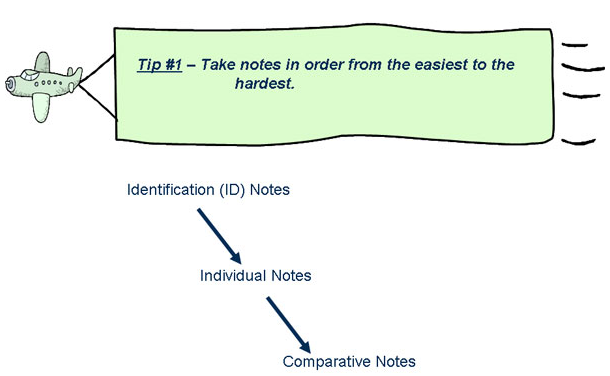
- Let's review the previously used example of the two market hogs, coupled on muscling, and look at how the notes were used to complete the following reasons for this top pair.
"Finding the two heaviest muscled hogs to start the class. I placed 1 over 2 because the black gilt was simply the nicer balanced, taller fronted hog of the pair."
Your Notebook at the Beginning of the Class
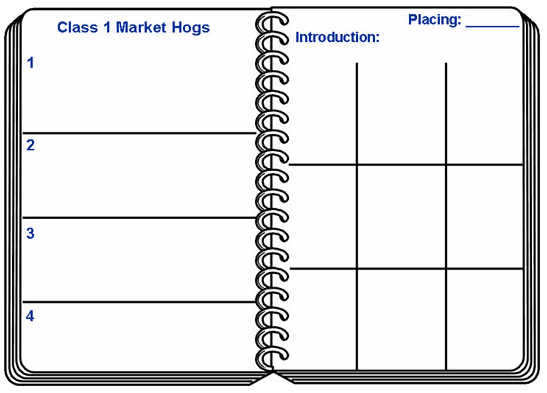
Developing Your Notes
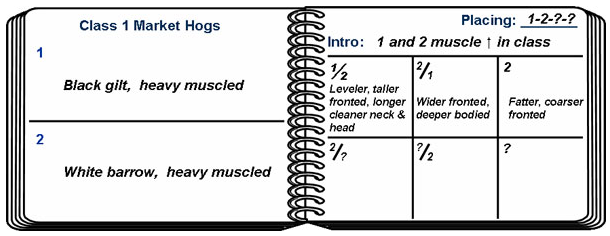
- As you start, you easily see that 1 is a black gilt and 2 is a white barrow.
- You see that 1 and 2 are easily the two heaviest muscled hogs in the class.
- You see that, compared to 2, 1 is leveler from a side view and taller at the shoulders, and longer and cleaner necked. You are pretty sure 1 will beat 2.
- You see that 2 is wider fronted and deeper bodied than 1.
- You see that 2 is not only coarser fronted, but also fatter than 1.
Example Reasons for the Top Pair Based on Your Notes
"Finding the two heaviest muscled hogs to start the class, I placed 1 over 2 because the black gilt was simply the nicer balanced, taller fronted hog of the pair. 1 was leveler in her profile and longer and cleaner necked. In addition, she was leaner made and should hang a carcass with a higher percent lean.
I do grant that 2 was higher volume, wider chested and deeper bodied.
But I faulted the white barrow and placed him second because he had more fat cover and was coarser fronted."
Cautions from Example
- Realize this is just an example of a top pair only. If this were a real class, you may have had other big differences to study and note on the top remaining two animals before placing the top pair.
- For example, 3 may have been a light muscled red gilt. This would have been easily noted before studying and placing the top pair.
- Remember, take notes from the easiest to the hardest (ID, individual, then comparative notes).
Note Taking Tips

- Time is limited to judge a class (10-15 minutes).
√ Not a lot of time to spend writing. - Develop a system of shorthand or abbreviations to use for note taking.
√ Personalize them so they make sense to you.
Example Abbreviations
|
|
Note Taking Tips

- If everything looks the same don't panic.
√ Look away from the class.
√ Take a deep breath.
√ Remind yourself of the judging priorities.
√ Then begin noting the obvious differences. - Develop a habit of taking notes on every class during workouts (makes it become routine).
Note Taking Tips

- Use notes to develop a mental image of the animal.
- Never completely write out your reasons - your brain is quicker than your pencil.
- Take careful notes on close pairs - reason judges listen carefully to close pairs.

Terminology
- Proper livestock terminology is essential for effective reasons.
- Learning terminology is a never-ending process that will continue throughout your judging career.
√ Must challenge yourself to study term sheets and expand livestock vocabulary.
- Beginners - remember that simple, accurate terms are better than inaccurate, flowery terms.
Terminology Tips

- When beginning a reasons statement about an animal, first introduce the idea with a broad general term, and then use more specific terms that provide a more detailed description.
√ First tell what trait is, and then tell where or how the trait is expressed.
General and Specific Example
"3 was a higher volume heifer. She was bolder sprung and deeper in the rear flank."
- The general statement is 3 was "higher volume"
(that's the what). - The specific terms are "bolder sprung and deeper in the rear flank"
(that's the where or how that she is higher volume). - This method teaches beginners to get the main point across first and then build on it.
General and Specific Example
- As your livestock vocabulary and reasons experience increases, you may actually reverse the order and go from specific to general.
"However, I criticize 3 and placed her 3rd because she was coarse headed, thick necked and tight flanked, lacking the overall femininity and angularity of 2."
- In this case, the specific terms of coarse headed, thick necked and tight flanked all add up to the general statement of femininity.
√ This order is most effective for use in fault or criticism statements, or when wrapping up the bottom placing animal.
Terminology Tips

- Terms must match the specie you are discussing.
√ Sheep - dock, hind saddle, breast, leg, etc
√ Swine - ham, jowl, seam of ham, % lean, etc.
√ Cattle - brisket, quarter, fleshing ability, yield grade, etc.
Purpose Specific Terms
- Since market animals are raised for meat production, market classes of livestock should include some carcass terminology.
"The black steer is more correctly finished and should hang a carcass with a more desirable quality grade."
"The white barrow is over-finished and when taken to the rail will have the lowest percent lean."
Purpose Specific Terms
- Breeding classes of livestock should have some reference to future production.
"4 was a more structurally correct, freer moving gilt that should be more functional in a confinement system."
"1 was a higher volume, easier fleshing heifer that should be an easier keeping cow."
Terminology Tips

- The four previous purpose specific reasons sentences were examples of statements or "spills".
- Over time you will learn to construct phrases from simple terms and then arrange them into statements or "spills".
√ Be careful not to just memorize a set statement or "spill", but learn to vary the terminology to fit the specific situation.
The Terminology Game
Playing the "terminology game" at practice or on road trips is a great way to learn phrases and spills.
- Coach calls out a general term and a species, such as muscle and hogs.
- Each person takes turns making a complete statement out loud.
- The challenge is everyone's statement or spill must be different.
- This is a great way for everyone to hear a variety of ways to describe the same traits.
Terminology Tips

- Being redundant means you use the same terms to describe the same traits over and over again in the same set of reasons.
√ Hard to listen to.
√ Results in lower scores.
Varying Your Terms
- Learn several ways to describe the various traits for eas specie.
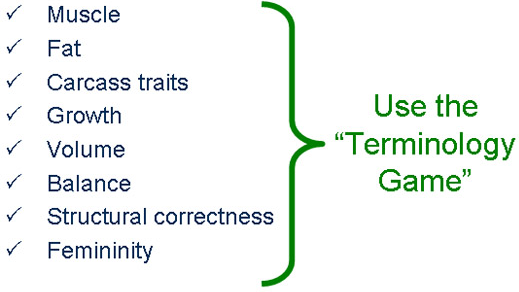
Vary Your Tranitions and Words of Emphasis
- Transtions - words and pharses that connect the trait terms.
EXAMPLES: "In my top pair"; "In addition"; "However, I criticize"
- Words of Emphasis - further descirbes, or calls attention to, a trait or idea that helps you and the reasons judge draw a mental picture.
EXAMPLES: "especially"; "appears to be"; "simply overpowers"
Transitions & Words of Emphasis
- What tranition phrase(s) and word(s) of emphasis are used in the example top pair reasons below?
I placed this class of Angus heifers 1-2-3-4.
Starting the class with the two highest volume heifers, in my top pair, I placed 1 over 2, as 1 combined volume and structural correctness to the highest degree. 1 was deeper-ribbed, bolder sprung and wider tracking on both ends. In addition, she was leveler from hooks to pins and moved out with a longer stride.
I grant 2 was more feminine being especially clean about the head and neck.
However, I faulted 2 and placed her 2nd because she was weaker topped and lighter muscled.
Answer
I placed this class of Angus heifers 1-2-3-4.
Starting the class with the two highest volume heifers, in my top pair, I placed 1 over 2, as 1 combined volume and structural correctness to the highest degree. 1 was deeper-ribbed, bolder sprung and wider tracking on both ends. In addition, she was leveler from hooks to pins and moved out with a longer stride.
I grant 2 was more feminine being especially clean about the head and neck.
However, I faulted 2 and placed her 2nd because she was weaker topped and lighter muscled.
Transitions & Words of Emphasis
- What transition phrase(s) and word(s) of emphasis are used in the example middle pair reasons below?
Moving to my middle pair, I placed 2 over 3 as she was bigger volumed and deeper from forerib to rear flank. Furthermore, 2 is carrying more condition than 3 and appears to be easier-keeping.
I do admit the slick-haired heifer was heavier muscled and thicker in her rear quarter.
However, I criticized 3 and placed her 3rd because she was coarse headed, thick necked and tight flanked, lacking the overall femininity and angularity of 2.
Answer
Moving to my middle pair, I placed 2 over 3 as she was bigger volumed and deeper from forerib to rear flank. Furthermore, 2 is carrying more condition than 3 and appears to be easier-keeping.
I do admit the slick-haired heifer was heavier muscled and thicker in her rear quarter.
However, I criticized 3 and placed her 3rd because she was coarse headed, thick necked and tight flanked, lacking the overall femininity and angularity of 2.
Transitions & Words of Emphasis
- What transition phrase(s) and word(s) of emphasis are used in the example bottom pair reasons below?
Now, in my final pair, I placed 3 over 4. 3 simply overpowered 4 in growth and performance. She was larger framed and bigger outlined exhibiting more weight per day of age.
I realize 4 was a deeper bodied heifer, especially in her rear flank.
But this does not compensate for the fact that 4 was the smallest framed, slowest growing heifer in the class.
Answer
Now, in my final pair, I placed 3 over 4. 3 simply overpowered 4 in growth and performance. She was larger framed and bigger outlined exhibiting more weight per day of age.
I realize 4 was a deeper bodied heifer, especially in her rear flank.
But this does not compensate for the fact that 4 was the smallest framed, slowest growing heifer in the class.
Terminology Tips

- There are certain words or phrases that can take away from a good set of reasons.
√ Any words that are questionable, or may be a distraction to the reasons judge, should be avoided.
Words or Phrases to Avoid (1)
- "Number" - Refrain from using the word "number." If the animal's number is 4, then call him "4" just as if this were his name.
- "It" - Never use the neuter pronoun. Every animal has a sex, and should be referred to as "he" or "she".
- "Better" - This is a nonspecific word that should not be used.
- "Animal or Individual" - Avoid these nonspecific words. Instead, say bull, heifer, steer, boar, gilt, barrow, ram, ewe, wether, etc.
- "Is a steer that is" - For example, "4 is a steer that is thicker and heavier muscled." This is too words, instead say "4 is thicker and heavier muscled."
- "Lacks or lacking" - Use these words sparingly.
For example, "I fault 2 because he lacks muscling" would be more effective and more direct if stated "I fault 2 because he is lighter muscled." - "For being" - Instead of saying, "I fault 2 for being lighter muscled", say "I fault 2 because he is lighter muscled."
- Words ending in "ing" - For example, words such as "faulting" and "placing" should never be used. These words are weak. Instead say "I placed" or "I fault".
- "Kind of" - Instead of saying "a fatter kind of gilt", say "a fatter gilt".
- "Carries" or "Carrying" - Instead of saying "carries down into a thicker quarter", say "has a thicker quarter".
- "Was a" or "is a" - Limit the number of times you follow the word "was" or "is" with the word "a". When you use these words in combination, you will have to use a noun, such as heifer, bull, gilt, steer, etc., somewhere in the sentence. For example, instead of saying "2 was a heifer with higher volume" or "2 was a higher volume heifer", say "2 was higher volume".
Slang Words
- Avoid the use of barnyard slang when giving oral reasons. These words are fine for casual conversation, but not for oral reasons.
- Example of slang words include:
|
"runt" "ding" "gutless" "snake" "sorry" |
"showstopper" "hoss" "sweet" "moves like a cat" |
Fluff and Flower
- Be careful of using too much fancy terminology
√ There is a fine line between adding a littly style to reasons, and overdoing it.
√ Always try out new terms or fancy introductions on your coach during practice, not at the contest.
- Remember, accuracy is much more important than fancy words.

Delivery and Presentation
Your coach says, ....
"Time to work up your reasons on the Charolais bull class. I need the first set in fifteen minutes."
Are you nervous?
YOU BET!!!
Is it Okay to be Nervous?
- Sure it is.
- Just remember these things:
√ You are learning one of the most important life skills - the skill of effective communication.
√ Even great public speakers get nervous.
√ However, great public speakers are prepared.
√ Proper preparation will instill a sense of confidence that will help overcome the nerves.
Preparing a Set of Reasons
- Preparing the oral presentation, or "working up" your reasons, can seem overwhelming for a beginner.
- However, if you will use the same system or method of preparation for every set, the actual presentation portion of the process will be much easier.

- Transfer ID or individual trait notes to the right hand side of your notebook next to the pair notes.
√ This is the first step in developing the mental picture of each animal in the class.
- Caution - do not get into the habit of writing out your reason statements. It's too time consuming and limits your ability to visualize the animals.

From your notes, you need to be able to generate a mental picture (visualize) the animals and pairs in the class.
Develop the Mental Picture
- Concentrate on the ID traits and begin to visualize the individual animals in the class.
- Now visualize the top pair beginning first withthe top placing animal and then the 2nd place animal.
- Refer to your notes on this pair and begin to talk the pair in your mind as you see them.
- Apply the terminology statements that fit the comparative notes you took on this pair.
- As you get comfortable with the top pair, move on to the middle pair, and then the bottom pair.
Preparing a Set of Reasons

- Although you should never memorize a set of reasons you should memorize a few key elements of your presentation.
Memorize the Numbers
- Repeat the placing and the pair numbers over and over again until they are committed to memory.
- For example, if your placing is 4-2-3-1, then repeat to yourself...
√ "4-2-3-1", "4-2-3-1", "4-2-3-1", etc., over and over again to memorize the placing.
√ "4-2, 2-3, 3-1", "4-2, 2-3, 3-1", "4-2, 2-3, 3-1", etc., over and over again to memorize the pairs.
- This will reduce the chance of you mixing up the numbers during presentation.
Memorize the Introduction and the Next Statement
- Why?
√ It breaks the ice.
√ Gets you off to a good start.
√ Gets the words flowing.
√ Makes a good first impression.
Memorize the Transitions
- Memorize the pair transitions used to introduce the middle and bottom pairs.
EXAMPLES: "Moving to my middle pair"; "Now in my final pair"; Upon analysis of the middle pair"; etc...
- Memorize the grant and fault transitions.
EXAMPLES: "I admit"; "I grant"; "I fault"; "I criticize"; "However, I faulted"; "But this does not compensate for the fact that;" etc
Memorize the Closing Statements
- Closing statements consist of two parts:
- The fault or criticism of the last place animal.
√ You should not over criticize the last placed animal - you may be talking to its owner.
- Any set ending your coach instructs you to use.
√ Some coaches may want you to simply end with "Thank You".
√ Others may want you to repeat your placing - "For these reasons I placed this class of . . . 1-2-3-4.
Key Points to Remember
- The introduction sets the tone of the reasons presentation.
- The discussion of the close pair(s) shows whether you really saw the class.
- The closing statement is the last thing the judge hears before writing down your score.
Preparing a Set of Reasons

- You will typically have 5-10 minutes between sets of reasons. You will need to use your time wisely.
Practice Your Delivery
- Practice your delivery - then practice again, then practice again, then practice again..., etc.
- Fine tune your deliver - decide which points to emphasize and which emphatic words to use.
- Reasons presentations are a mental marathon, and contests are usually won and lost during the afternoon reasons session.
- Maintain your focus and concentration. Do not waste time or daydream.
How to Use Your Voice
- A young child leaning to read their first storybook has little expression and speaks monotone because they are concentrating on getting every word right.
- Ask the same child to tell you the story they just read and you will be entertained by a story told with expression and excitement that is fun to listen to.
- It's the same with reasons. Use your voice to make reasons easier to listen to.
√ Focus on your volume, speed, inflection, and expression.
Voice Volume
- Talk in a louder than conversational voice, but do not shout.
√ Don't break the ear drums of the reasons judge, but don't make them strain to hear what you are saying.
- Adjust your volume to fit the surroundings and background noise.
Voice Speed
- Be aware of your voice speed.
√ Beware of talking too rapidly just to get it over with.
√ Beware of talking so slowly the reasons judge loses interest.
- Slow down when emphasizing a point.
Voice Inflection
- Voice inflection refers to the pitch or tone of your voice.
- When ending a thought or sentence, the inflection or tone of your voice should usually go down.
- However, when you end a phrase or statement with a rising tone or pitch, you are telling the listener more about the current thought coming.
√ For example, grant statements usually end with a rising inflection because a fault statement will follow to reemphasize why the animal placed 2nd in that pair.
Expression
- Be expressive and emphatic when making a point.
- You may gesture slightly with your head, but refrain from using any other body gestures or movements.
- Avoid being overly dramatic - its just a set of reasons, not a Broadway musical.
- Be yourself. Your reasons will be easier to present and will be more sincere than if you try to take on another personality.
Reasons Room Etiquette
- Be prompt when your turn comes up to present a set of reasons.
√ However, if you get caught short between sets and really need a few more minutes, ask the official for more time. They may or may not give it to you.
-
Have your notes with you at all times, but never look at them during your presentation nor let the reasons judge see them.
√ Tuck them behind you in your waistband.
- Enter the room with an air of confidence, but don't have an air of cockiness.
- If the reasons judge offers you your placing card when you enter the reasons room, politely refuse it by saying "no thank you".
- Don't stand too close to or too far away from the reasons judge.
√ Eight to ten feet is usually about right, depending upon the strength of your voice and size of the room.
- Stand with your feet spread to about the width of your shoulders. Stand erect and keep both your hands behind your back. Try to avoid leaning over too far as you talk.
- Look the reasons judge squarely in the eye when you talk or at least give them that impression (look at the forehead).
√ Above all, do not let your eyes wander.
- NEVER give reasons while chewing gum or tobacco. In addition be sure your shirt is tucked and remove your hat.
√ Try as hard as you can to be both pleasing to listen to and to look at.
- If you stumble or draw a blank during your delivery, simply restate your previous statement ending the statement with a falling inflection. Then picture the next animal and move on.
√ Do not apologize or get overly emotional.
- Remember - you are being judged from the time you enter the room until you leave.
√ Be professional and courteous at all times.
On to the Next Set
- You've just completed your first set of reasons.
What happens now?
√ The judge may ask you a question or comment on your performance.
√ Answer all questions to the best of your knowledge, and NEVER guess or lie. If you are not sure of the answer, then say "I don't know".
- How many sets of reasons will you give?
√ High school age divisions usually require 2-4 sets.
√ Collegiate divisions usually require 5-8 sets.
- Make sure you understand the reasons order and know which class you will give next.
- Give yourself a 2 - 3 minute break to clear your mind of the last set.
√ You must leave everything that happened with the previous set behind and move on.
Final Tips
- Nervous jitters are a normal part of giving oral reasons - preparation and concentration are the keys to success.
- Learn to relax and enjoy the challenge.
- These skills you learn from presenting oral reasons will benefit you for a lifetime.
